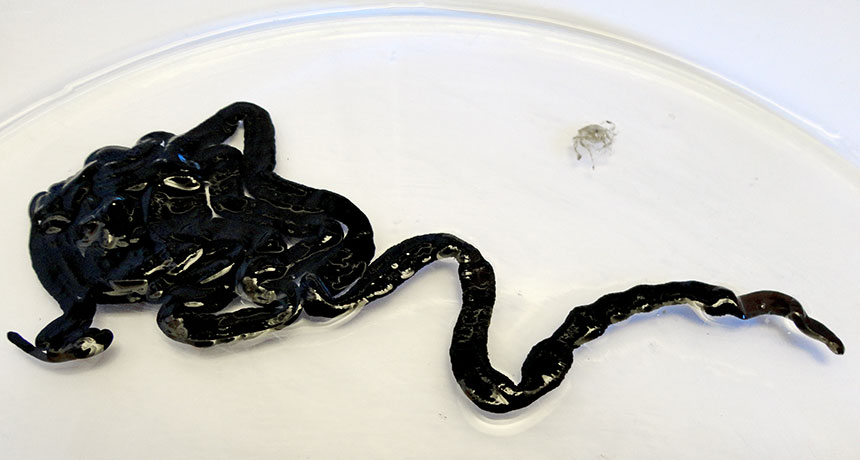
THANK THIS WORM A bootlace worm glides along in its mucus, which has newly described toxins shown to paralyze or kill cockroaches and invasive crabs.
Erik Jacobsson
Bootlace worms with spooky-stretchy bodies secrete a family of toxins new to scientists. These compounds might inspire novel ways to attack pests such as cockroaches.
Tests first identified the toxins in mucus coating a bootlace species that holds the record as the world’s longest animal, says pharmacognosist Ulf Göransson of Uppsala University in Sweden. This champion marine worm (Lineus longissimus) can stretch up to 55 meters, longer than an Olympic-sized pool, and coats itself in mucus smelling a bit like iron or sewage. That goo holds small toxic proteins, now dubbed nemertides, that are also found in 16 other bootlace worm species, Göransson and colleagues write March 22 in Scientific Reports.
The newly described nemertides attack tiny channels in cell walls that control the amount of sodium flowing in and out of the cell. Much vital cell business, such as communications between nerves, depends on the right flux through these voltage-gated sodium channels, as they’re called. Injections of small amounts of one of these nemertides permanently paralyzed or killed invasive green crabs (Carcinus maenas) and young cockroaches (Blattella germanica).
“This study certainly has a lot of novelty to it, since marine worms are a tremendously neglected area of venom research,” says Bryan Grieg Fry at the University of Queensland in Australia, where he explores the evolution of animal poisons.
Unlike earthworms, the 1,300 or so species of bootlace, or ribbon, worms have no segments. Some scientists give these animals their own phylum, Nemertea. Bootlace worms have a brain but no lungs. Like many other slender marine creatures, bootlace worms breathe directly through the skin. The worms are carnivorous, supping on crustaceans, mollusks and other worms.
They’re marvels of body expansion and contraction. An L. longissimus “of about 10 meters can be held in your hand as a slimy heap,” says study coauthor Malin Strand, a marine biologist and molecular systematist at the Swedish University of Agricultural Sciences in Uppsala. She estimates the worms could live for around 10 years “or maybe much longer.”
How L. longissimus or the other species in the study use their toxins isn’t clear, she says. The stringy creatures aren’t easy to keep in captivity, Strand says. She has some worms that have deigned to eat in her lab only once in three to four years.
Göransson proposes that toxic mucus may be useful for defense. He has seen video with Nemertean worms stretched out on the seafloor. “If you’re a crab or a fish, it must be tempting to take a nip,” he says, but there’s little sign of anything bothering them.
He once tried some bare-handed contact with a small lab specimen and didn’t feel much of anything, although he’s been warned about “tingling” or even hands going temporarily numb. One of the nemertide toxins tested in the new paper was 100 times as effective on sodium channels in insect cells as in mammal ones, the researchers found.
Still, Göransson prefers to wear gloves.






